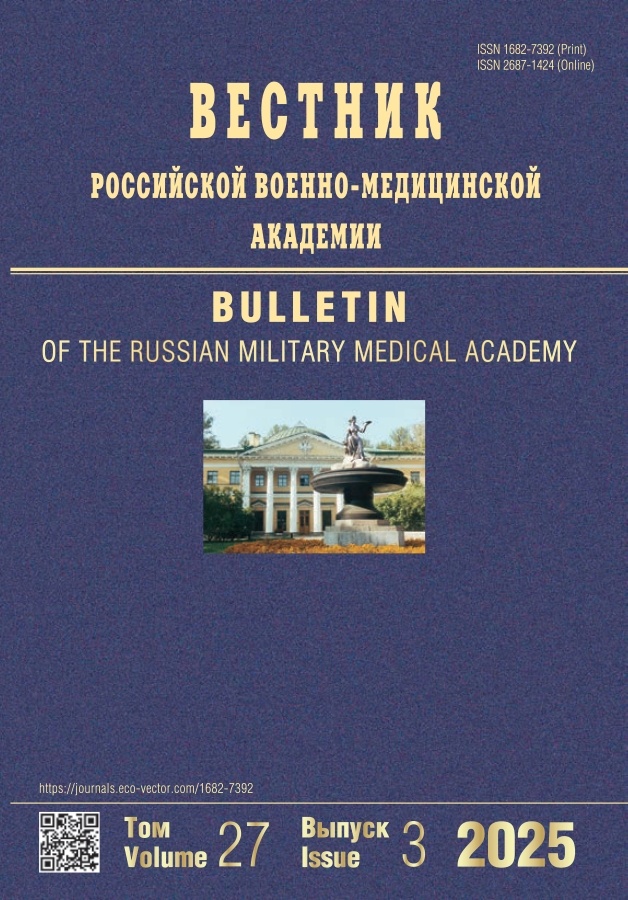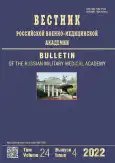Dynamics of the content of immunoglobulin G to severe acute respiratory syndrome-2 in convalescents who have had a new coronavirus infection
- 作者: Fateev I.V.1,2, SchÖfer T.V.1, Chepur S.V.1, Ivchenko E.V.2, Minnullin T.I.1, Shubina A.A.1, Stepanov A.V.1
-
隶属关系:
- State Research Testing Institute of Military Medicine
- Military Medical Academy of S.M. Kirov
- 期: 卷 24, 编号 4 (2022)
- 页面: 659-666
- 栏目: Original Study Article
- URL: https://journals.rcsi.science/1682-7392/article/view/134065
- DOI: https://doi.org/10.17816/brmma108612
- ID: 134065
如何引用文章
详细
The study investigated the dynamics of class G immunoglobulins to severe acute respiratory syndrome-2 coronavirus in the blood serum of convalescents who had a new coronavirus infection for 6 months after the polymerase chain reaction conversion. Among the most common symptoms, 30 (73.8%) convalescents had an increase in body temperature to 38°C, 32 (83.3%) had asthenia, 21 (59.5%) had cough, 29 (73.8%) had perversion or loss of sense of smell, pain, and throat discomfort. The duration of symptoms varied from 3–4 days to 3–4 weeks. Within a month after the end of the acute disease period, 8 (20%) patients had a decrease in working capacity, 13 (33%) had difficulty breathing, 9 (22%) had a cough, and 4 (10%) had pain and sore throat. During severe acute respiratory syndrome 2 infection, the virus activates the innate and adaptive immunity, resulting in the formation of specific class G immunoglobulins to the pathogens. After leveling the clinical manifestations, class G immunoglobulins were detected in the majority of convalescents (79%–90%) during the first 6 months, starting from day 14 from disease onset with a predominantly high (> 10 conl. units) positivity coefficient. Moreover, this pattern occurred in both men and women; however, in some studies, the levels of the positivity coefficient of class G immunoglobulins began to decrease by the fifth month of follow-up and sometimes at an earlier time (2 months). Perhaps, this is due to the different functional activities of the immune system of each convalescent, infecting dose of the pathogen, and peculiarities of its interaction with the macroorganism and its immune system. Nevertheless, the class G immunoglobulins identified in the study do not yet indicate the probability of reinfection of convalescents with the same pathogen. The protective titer of antibodies has yet to be investigated further.
作者简介
Ivan Fateev
State Research Testing Institute of Military Medicine; Military Medical Academy of S.M. Kirov
编辑信件的主要联系方式.
Email: gniiivm_2@mil.ru
ORCID iD: 0000-0003-4014-3973
SPIN 代码: 5781-0083
doctor of medical sciences
俄罗斯联邦, Saint Petersburg; Saint PetersburgTimur SchÖfer
State Research Testing Institute of Military Medicine
Email: gniiivm_2@mil.ru
ORCID iD: 0000-0001-7303-0591
SPIN 代码: 8739-8385
doctor of medical sciences
俄罗斯联邦, Saint PetersburgSergey Chepur
State Research Testing Institute of Military Medicine
Email: gniiivm_2@mil.ru
ORCID iD: 0000-0002-5324-512X
SPIN 代码: 3828-6730
doctor of medical sciences, professor
俄罗斯联邦, Saint PetersburgEvgeniy Ivchenko
Military Medical Academy of S.M. Kirov
Email: gniiivm_2@mil.ru
ORCID iD: 0000-0001-5582-1111
SPIN 代码: 5228-1527
Scopus 作者 ID: 55571530400
doctor of medical sciences, associate professor
俄罗斯联邦, Saint PetersburgTimur Minnullin
State Research Testing Institute of Military Medicine
Email: gniiivm_2@mil.ru
ORCID iD: 0000-0001-8985-4878
SPIN 代码: 6856-7819
candidate of medical sciences
俄罗斯联邦, Saint PetersburgAlla Shubina
State Research Testing Institute of Military Medicine
Email: gniiivm_2@mil.ru
ORCID iD: 0000-0003-0924-8654
SPIN 代码: 1045-7885
Senior Researcher
俄罗斯联邦, Saint PetersburgAlexander Stepanov
State Research Testing Institute of Military Medicine
Email: gniiivm_2@mil.ru
ORCID iD: 0000-0002-1917-2895
SPIN 代码: 7279-7055
doctor of medical sciences
俄罗斯联邦, Saint Petersburg参考
- Phelan AL, Katz R, Gostin LO. The novel coronavirus originating in Wuhan, China: challenges for global health governance. JAMA. 2020;323(8):709–710. doi: 10.1001/jama.2020.1097
- Marik PE, Iglesias J, Varon J, et al. A scoping review of the pathophysiology of COVID-19. Int J Immunopathol Pharmacol. 2021;35. doi: 10.1177/20587384211048026
- Machhi J, Herskovitz J, Senan AM, et al. The natural history, pathobiology, and clinical manifestations of SARS-CoV-2 infections. J Neuroimmune Pharmacol. 2020;15(3):359–386. doi: 10.1007/s11481-020-09944-5
- Elrobaa IH, New KJ. COVID-19: Pulmonary and extra pulmonary manifestations. Front Public Health. 2021;9:711616. doi: 10.3389/fpubh.2021.711616
- Zaitsev AA, Golukhova EZ, Mamalyga ML, et al. Efficacy of methylprednisolone pulse therapy in patients with COVID-19. Clinical Microbiology and Antimicrobial Chemotherapy. 2020;22(2):88–91. (In Russ.). doi: 10.36488/cmac.2020.2.88-91
- Chen L, Xiong J, Bao L, et al. Convalescent plasma as a potential therapy for COVID-19. Lancet Infect Dis. 2020;20(4):398–400. doi: 10.1016/S1473-3099(20)30141-9
- Kryukov EV, Salukhov VV, Kotiv BN, et al. Factors affecting the content of IgG antibodies to SARS-CoV-2 S-protein in the blood of reconvalescents after a new coronavirus infection (COVID-19). Medical Advice. 2022;16(4):51–65. (In Russ.). doi: 10.21518/2079-701Х-2022-16-4-51-65
- Li Х, Zhang Y, He L, et al Immune response and potential therapeutic strategies for the SARS-CoV-2 associated with the COVID-19 pandemic. Int J Biol Sci. 2022;18(5):1865–1877. doi: 10.7150/ijbs.66369
- Merad M, Blish CA, Sallusto F, et al. The immunology and immunopathology of COVID-19. Science. 2022;375(6585):1122–1127. doi: 10.1126/science.abm8108
- Moss P. The T cell immune response against SARS-CoV-2. Nat Immunol. 2022;23(2):186–193. doi: 10.1038/s41590-021-01122-w
- Jamal M, Bangash HI, Habiba M, et al. Immune dysregulation and system pathology in COVID-19. Virulence. 2021;12(1):918–936. doi: 10.1080/21505594.2021.1898790
- Gusev E, Sarapultsev A, Solomatina L, et al. SARS-CoV-2-Specific immune response and the pathogenesis of COVID-19. Int J Mol Sci. 2022;23(3):1716. doi: 10.3390/ijms23031716
- Primorac D, Vrdoljak K, Brlek P, et al. Adaptive immune responses and immunity to SARS-CoV-2. Front Immunol. 2022;13:848582. doi: 10.3389/fimmu.2022.848582
- Rybkina K, Davis-Porada J, Farber DL. Tissue immunity to SARS-CoV-2: Role in protection and immunopathology. Immunol Rev. 2022;309(1):25–39. doi: 10.1111/imr.13112
- Jiang HW, Li Y, Zhang H, et al. SARS-CoV-2 proteome microarray for global profiling of COVID-19 specific IgG and IgM responses. Nat Commun. 2020;11:3581. doi: 10.1038/s41467-020-17488-8
- Choudhary HR, Parai D, Dash GC, et al. IgG antibody response against nucleocapsid and spike protein post-SARS-CoV-2 infection. Infection. 2021;49(5):1045–1048. doi: 10.1007/s15010-021-016514
- Ivanov A, Semenova E. Long-term monitoring of the development and extinction of IgA and IgG responses to SARS-CoV-2 infection. J Med Virol. 2021;93(10):5953–5960. doi: 10.1002/jmv.27166
- Xiao DAT, Gao DC, ZhangDS. Profile of specific antibodies to SARS-CoV-2: The first report. J Infect. 2020;81(1):147–178. doi: 10.1016/j.jinf.2020.03.012
- Amanat F, Stadbauer D, Strohmeier S, et al. A serological assay to detect SARS-CoV-2 seroconversion in humans. Nature Medicine. 2020;26:1033–1036. doi: 10.1101/2020.03.17.20037713
- Smetanina SV, Isaeva AN, Isaeva OO, et al. Change in anti-SARS-CoV-2 IgG antibodies (COVID-19) among the population of the Russian Federation regions and in convalescents in dynamics. Consilium Medicum. 2020;22(11):47–50. (In Russ.). doi: 10.26442/20751753.2020.11.200417
- Szymczak A, Jędruchniewicz N, Torelli A, et al. Antibodies specific to SARS-CoV-2 proteins N, S and E in COVID-19 patients in the normal population and in historical samples J Gen Virol. 2021;102(11):001692. doi: 10.1099/jgv.0.001692
- Barchuk A, Skougarevskiy D, Kouprianov A, et al. COVID-19 pandemic in Saint Petersburg, Russia: Combining surveillance and populationbased serological study data in May, 2020–April, 2021. Medrxiv. 2021:1–9. doi: 10.1101/2021.07.31.21261428
补充文件








